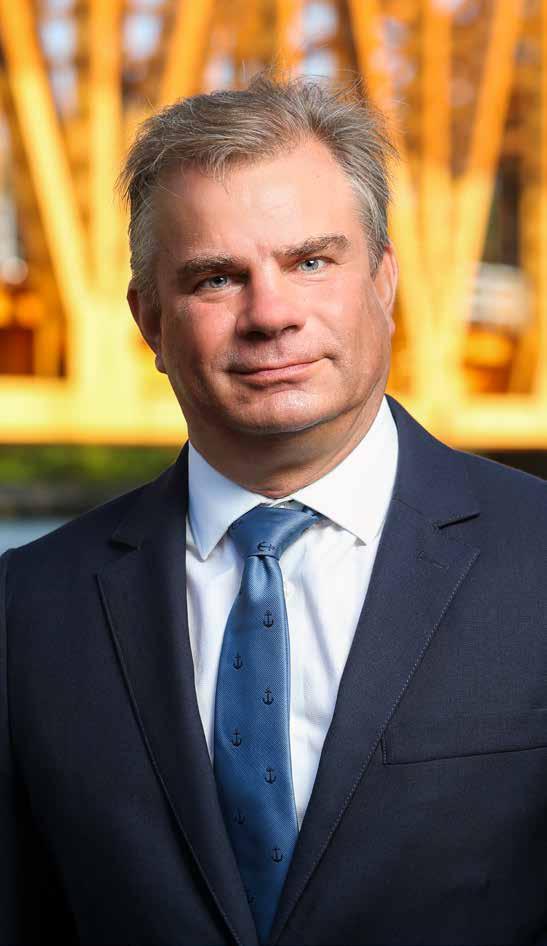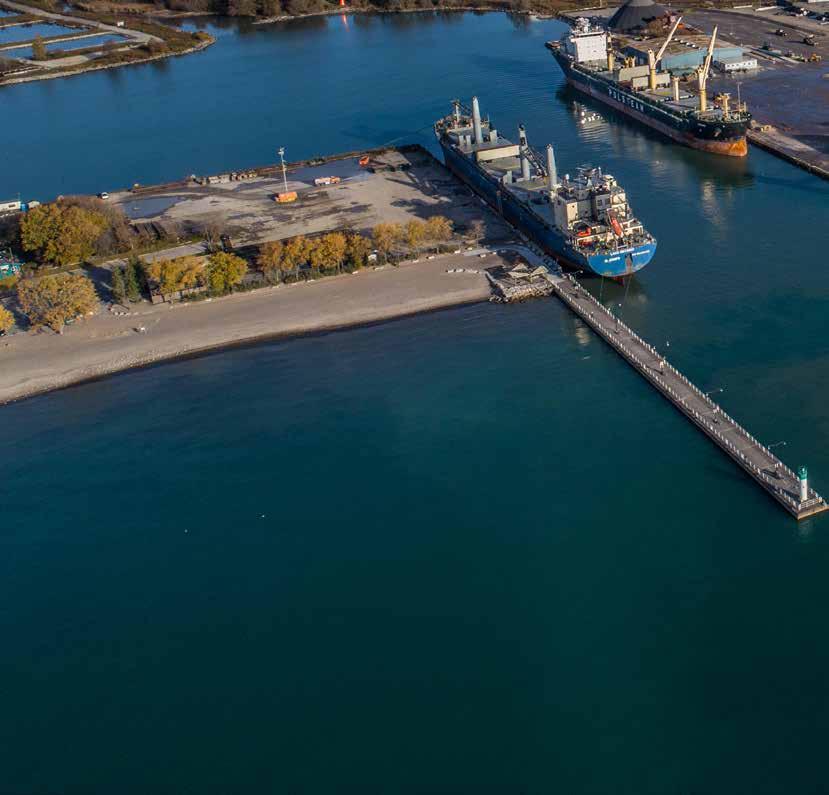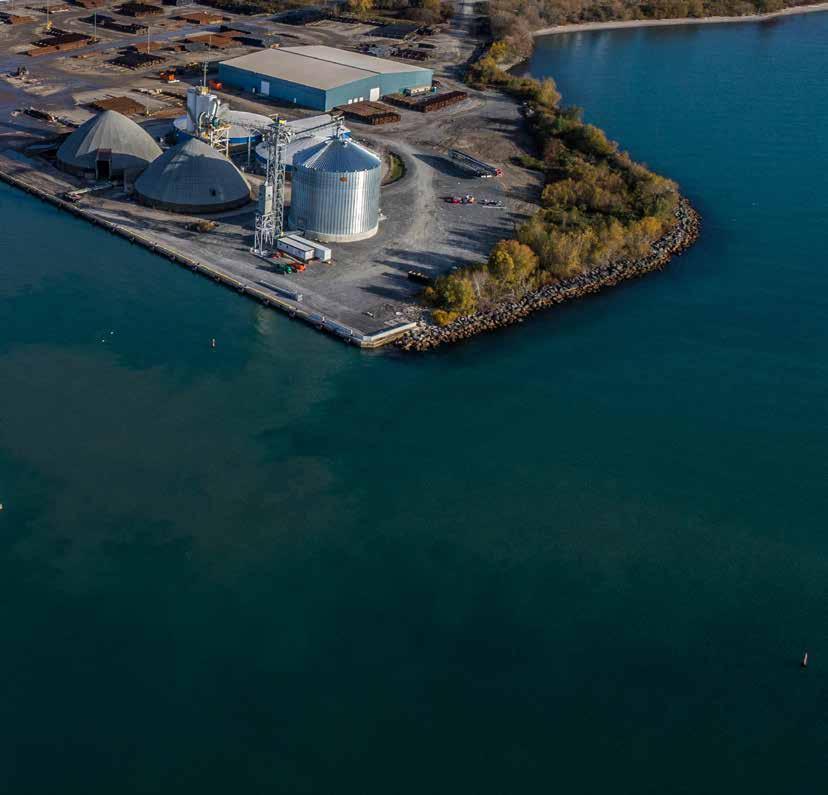
6 minute read
CONVERSATION WITH IAN HAMILTON
BY LEO RYAN
Canada’s biggest port entity on the Great Lakes, the Hamilton-Oshawa Port Authority has recently embarked on a number of initiatives to strengthen its competitive position and address the challenges of the 21st century. In an exclusive interview, Ian Hamilton, President and CEO, expressed his views on a wide range of subjects – including the urgency of exploiting greater marine transportation on the Great Lakes to support supply chain capacity and significantly reduce highway pollution, the prospects of a binational green shipping corridor and certain regulatory barriers that must be addressed.
Four years after the ports of Hamilton and Oshawa merged and also integrated assets in the Niagara region, what are the positive outcomes that have flowed from this major consolidation? Has it basically strengthened the overall structural strategy and competitiveness of Canada’s biggest port complex on the Great Lakes?
Indeed, four years ago, we created a vision of building and leading an integrated port network on the Great Lakes to support supply chain capacity. The first step in this process was in 2019 when the Hamilton Port Authority and the Oshawa Port Authority amalgamated to ensure long-term sustainability of port operations and strengthen the Canadian supply chain. It was a transformational process, illustrating the synergies that could come out of that vision and changing our brand such that we truly became a ‘port network’.
We are seeing positive results. By providing smaller ports with access to resources, we’re able to help them achieve their potential. Multiple locations and competitive environments create a strong value proposition in the market. We work hard to ensure we provide efficient gateways for cargo, create capacity where needed, and reduce greenhouse gas emissions and road congestion.
Many analysts consider that marine transportation on the Great Lakes is well positioned to respond to a ‘perfect storm’ of factors in southern Ontario supply chains and that its greater use could help resolve a myriad of current issues, including pollution caused by highway congestion, shortage of truck drivers, and climate change disruptions. Your thoughts?

I couldn’t agree more. There is a large amount of capacity available on the HWY H2O, whereas there is limited capacity with truck and rail. Marine offers a more sustainable solution for long-distance transportation of goods. Greenhouse gas emissions associated with marine transportation are overall far lower than that of rail or truck. Additionally, each vessel has the potential to carry the equivalent of over 900 truckloads, reducing road congestion, fuel consumption and addressing issues around driver shortages.
It is clear to us that our supply chains are vulnerable. By developing more marine services for cargo currently moving by ground transportation, we create new capacity and redundancy in the system. For the first time, industry, logistics companies and government are aligned and see the value of creating a robust and sustainable supply chain.
To do it successfully, we need to make the right investments and re-engineer supply chains in a way that will make Canada prosperous for generations to come.
Green shipping has in the past several years become a dominant preoccupation of the global marine industry. How does HOPA view the launching of recent stakeholder discussions for creating a bi-national green shipping corridor?
I love the idea of a bi-national green shipping corridor. The greatest improvement we can make to our supply chain from an environmental and reliability standpoint is to better utilize marine transportation.
Today, vessels are more efficient and using better fuels to reduce their environmental impact. We are seeing operators move towards cleanerburning fuels such as low-sulphur fuels and alternative fuels such as biofuel and hydrogen.
The main advantage would be in reducing the amount of ground transportation, particularly trucks, by utilizing marine transportation. Ideally, we create a modal balance by utilizing both trucks and marine in a complementary way.
HOPA has through the years taken a series of initiatives underlining its priority as a steward of the environment and promoter of environmental sustainability and biodiversity. This past April you announced a plan to acquire green hydrogen from the large Atura Power Niagara Hydrogen Centre, slated to be operational in 2024. Can you discuss how this is part of an overall strategy?
We are committed to making a difference when it relates to the sustainability of our operations. We view this in three different ways: the direct emissions we create; the type of energy we use and how sustainable it is; and lastly, working with industry to help them make operational changes that align with a port-wide mission to be positive environmental stewards of our land, air and water.
We are delighted to be able to work with shipping lines to support transition to new fuels, including accommodating fueling depots. When vessels are inport, we’re improving access to a green source of shore power. We are elated about the partnership with Atura Power and we are working closely with them and our partners to determine our role in the potential storage and distribution of hydrogen to transportation users.
Developing marine-served industrial spaces has emerged as a very important focus of HOPA’s commercial strategy, as recently illustrated by a big lease signed with Max Archer North America. In this connection, what are the benefits foreseen from the Thorold Multimodal Hub undertaking that has been described as a game-changer?
In both situations, our goal is to build capacity. This will allow us to increase the volume of material we can handle through the marine mode. We are working with partners to build these spaces to expand capacity and provide better access to marine.
We have been able to assemble the Thorold Multimodal Hub, a distinctive property spanning 470 acres with direct access to marine and rail transportation. The robust industrial buildings strengthen our supply chain capacity.
The 2022 shipping season saw more than 10 million metric tons of cargo transiting through the ports of Hamilton and Oshawa, with agri-food accounting for nearly one third of total volume that also comprises finished steel, breakbulk, liquid and dry bulk. What are the advantages that HOPA offers to facilitate agri-food exports? Has the war in Ukraine had an impact on any segment?

We’ve continued to invest, in partnership with our tenants, in building the material handling capacity both in Hamilton and Oshawa. In the last decade, HOPA and its partners have invested close to $400 million in infrastructure in the agriculture sector alone. The investments we’re making in upstream services tells a story about the raw material arriving in-port. We add value by being able to process it locally - reducing costs and emissions and improving the sustainability of our supply chain.
The earthquake in Turkey and the invasion of Ukraine will continue to have a direct impact on the supply and demand for food, fertilizers, and structural steel. As a result, Canadian grain producers experienced additional pressure, but thanks to investments, the supply chains are resilient. Canadian farmers have played a crucial role in meeting global supply deficit by delivering high-quality grain products.
HOPA last year completed major maintenance dredging at Oshawa and kicked off several capital improvements. How much capital expenditure in infrastructure projects is programmed for 2023?
We’re kicking off our $35 million capital improvement plan in Oshawa. This will improve the capacity to handle agricultural products produced by Durham region farmers. In addition, over the next five years, we anticipate spending $40 million annually in capital expenditures.
How would you rate the present approaches of the federal and Ontario governments in supporting the marine industry?
We applaud the Provincial government for its efforts in developing a maritime strategy and acknowledging the significant role maritime can play in establishing a robust and sustainable supply chain. We look forward to working with the Ministry of Transportation (MTO) as it shapes the policy and plan its implementation.
We also appreciate the investments made by the Federal government through the National Trade Corridors Fund (NTCF) and eagerly anticipate working with them in the development of programs around environment and sustainability to enable marine to effectively support these initiatives. We’re looking forward to a new infrastructure program or programs that support the greening of supply chains.
HOPA has expressed concern that on the regulatory front barriers still exist to efficiently develop its multimodal hubs for container operations. In particular this reportedly applies to a prolonged delay in accreditation from the Canada Border Services Agency for receiving bonded import containers.
In our fast-paced world, one of the challenges is keeping regulations aligned with policy. While we understand the resource constraints faced by the Canadian Border Services Agency, it is essential to find a solution that enables us to leverage all the advantages that marine transportation has to offer. In Ontario, that means the sufferance facilities to support growing and diversifying marine services on the Great Lakes. n








